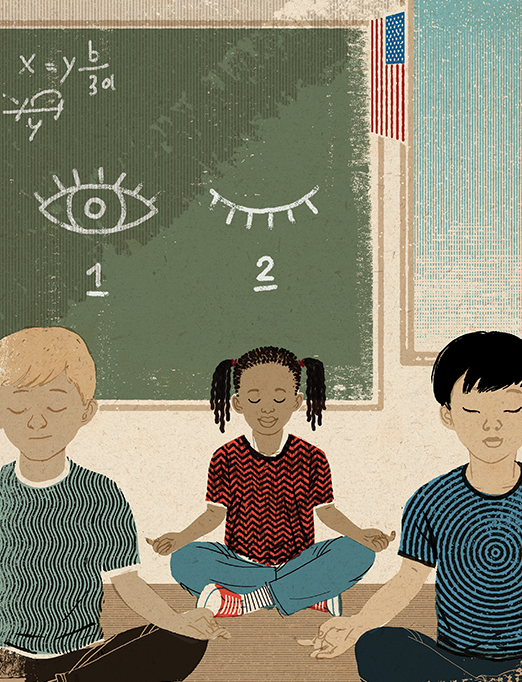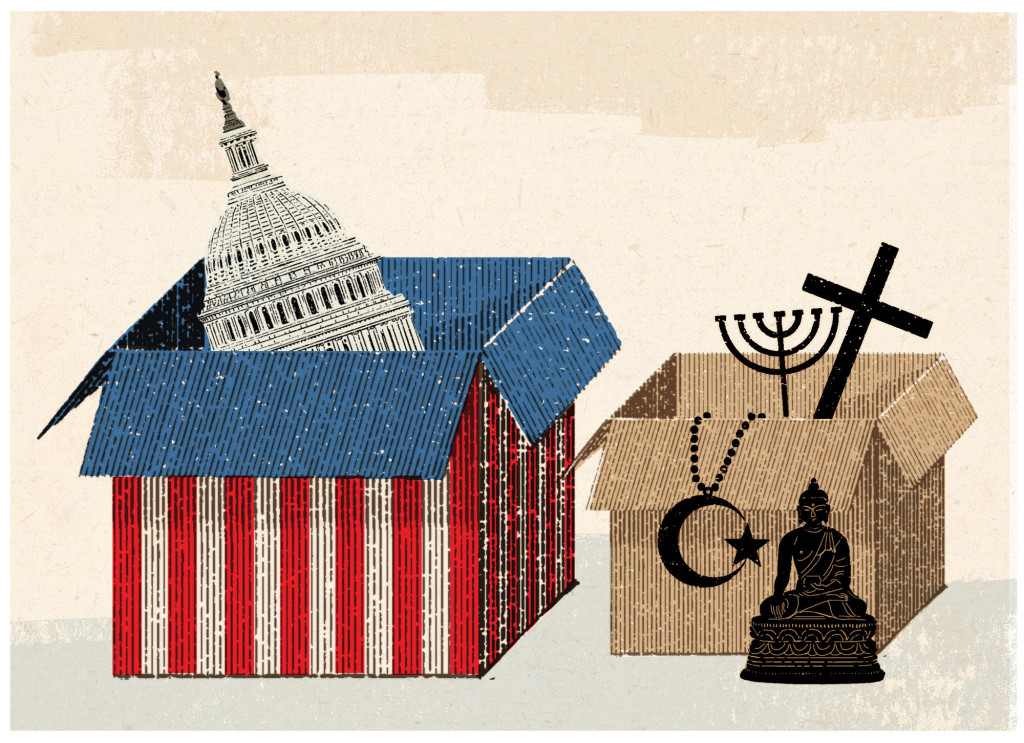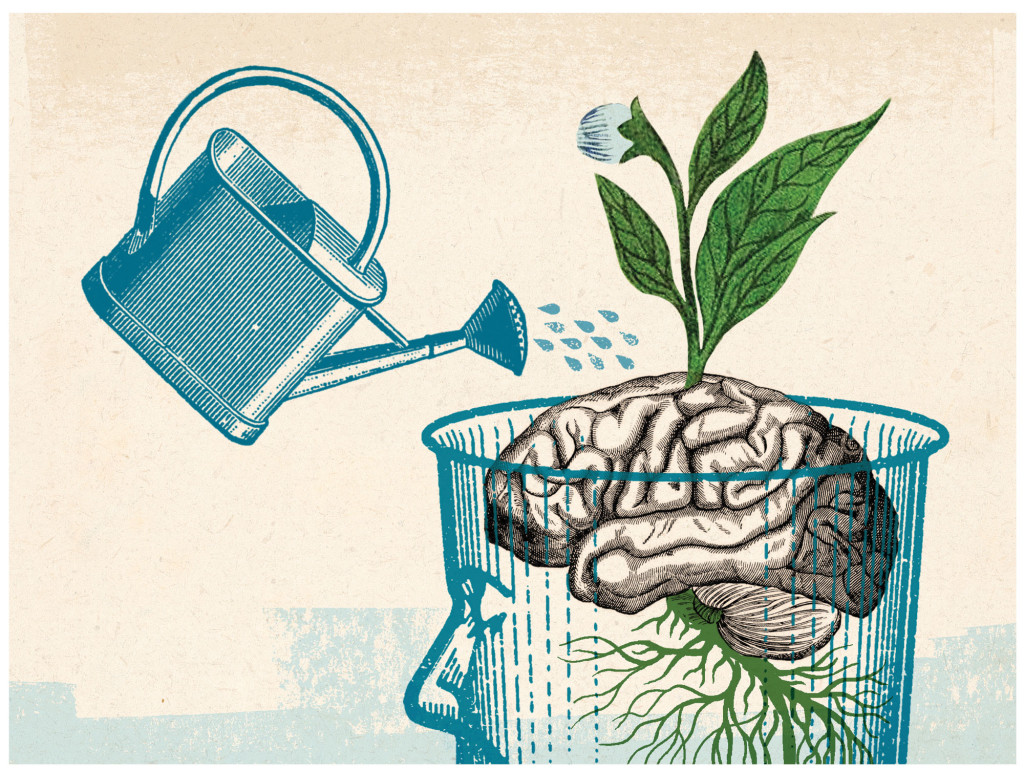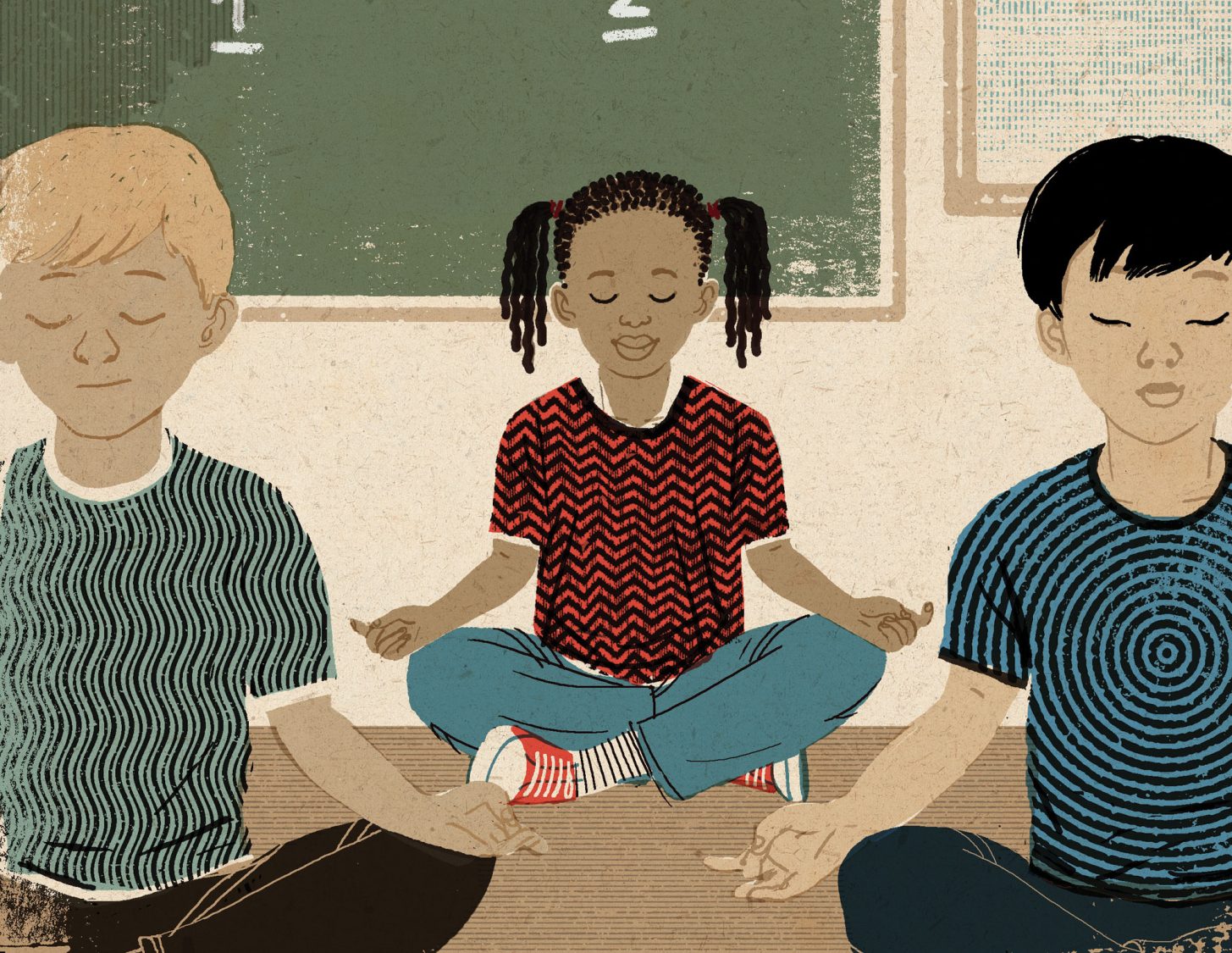Unless you’ve been in silent retreat for the past several years, you know that the “mindfulness revolution” sweeping the country is now playing out in the public sphere. The schools are no exception, and not everyone is happy about it: Is mindfulness an educational tool, teaching skills that make kids more attentive and emotionally balanced? Or is it a religious practice—Buddhism in secular clothing—violating the Constitution’s separation of church and state? Is it a universally beneficial practice, or are its proponents introducing a cultural bias when they bring the practice to underserved schools? Weighing in are Dr. Candy Gunther Brown, Professor of Religious Studies at Indiana University, Bloomington, and Dr. Saki Santorelli, Executive Director of the Center for Mindfulness in Medicine, Health Care, and Society at the University of Massachusetts Medical School.

NO—with its roots in religious tradition, teaching mindfulness in public schools violates the separation of church and state.
Wouldn’t every schoolchild and teacher be better off if they had the tools of mindfulness meditation? To those who have experienced the benefits of mindfulness, the answer to this question may seem an obvious “Yes!”
Such confidence in the practice of mindfulness meditation, however, can create an ethical blind spot that ignores its religious content, as well as the context of its implementation. Although it is not uncommon for proponents of mindfulness to assert, in certain contexts, that mindfulness is purely secular, it is also common for them, in other contexts and particularly among fellow Buddhists, to declare that mindfulness embodies the essence of buddhadharma—a case of wanting to have one’s cake and eat it too. Certain leading proponents envision “secular” mindfulness as “stealth Buddhism,” a “skillful means,” or a “Trojan horse” for mainstreaming the dharma.
When it comes to bringing mindfulness meditation into public schools, this can create a problem. Children and their parents expect—and laws require—public schools to offer secular education that is neutral toward particular religions and religion in general. There are reasons for this limitation. Public schools serve children, parents, and teachers from diverse cultural backgrounds, many of whom already have deeply cherished religious traditions and spiritual resources that they find effective.

The fact that the majority of public school mindfulness programs are supported and administered by upper- and upper-middle-class Buddhists of European descent, yet target lower- and working-class minority populations, only adds to this problem. These minority communities, mainly African American and Latino, are statistically more religiously active than the non-Hispanic, white American populations who generally run mindful school programs.
At worst, such programs can inadvertently participate in a cultural imperialism that not only condescends to racial and ethnic others, who are seen as having unenlightened religious and cultural practices, but also puts undue responsibility on children for ameliorating symptoms of systemic social problems such as poverty and racism, which are glossed as cultural pathologies. Insofar as these programs reinforce the hope that we can tackle systemic problems with small, low-cost, philanthropy-funded programs that modify the behavior of the disadvantaged, they can even make things worse.
It’s painfully obvious to most observers that the American public education system needs something that will better address rampant challenges afflicting so-called urban schools, such as low achievement, stress, obesity, drugs, and violence, and mindfulness seems an easy fix. Mindfulness could potentially boost test scores and facilitate focused attention, emotional self-regulation, and classroom management.
Related: The Value of Mindfulness in the Classroom
But it might also constitute both a religious and a cultural encroachment. The fact that there exist secular benefits to mindfulness does not make the practice secular. Abundant scientific research demonstrates that religion and spirituality promote physical and mental health and learning. Studies of prayer, for example, report benefits similar to those of mindfulness. But we wouldn’t integrate prayer into a public school curriculum. In the end, appeals to science can’t simply speak religion away.
Yet mindfulness proponents attempt to do just that, declaring the “secularity” of mindfulness without defining the terms religion or secularity or explaining how mindfulness has been secularized. Alleging that mindfulness is a “nonsectarian,” “universal” human capacity—to simply “wake up” and “see things as they really are”—justifies upholding one culturally particular worldview as superior to others. This not only smacks of cultural arrogance; it is precisely a religious attitude—a claim to special insight into the cause and solution for the ultimate problems that plague humanity.
None of this is meant to argue against offering optional mindfulness training for public school children or teachers—for instance, as an after-school program, if advertised clearly and consented to by children and their parents with knowledge of all it entails. But integrating mindfulness as a formal part of the public school day is a different matter.
The fact that there exist secular benefits to mindfulness does not make the practice secular.
Instructors—both mindfulness trainers and public school teachers—occupy authoritative social positions that command students’ respect and trust. The context of classroom instruction (or schoolwide assemblies) exerts an indirect, coercive pressure to conform to what the teacher says to do and peers can be observed as doing. Even when opt-out provisions exist, it is socially costly for children to appear to question the teacher’s wisdom or to deviate from the behavior of their peers. When mindfulness activities are scattered throughout the school day—a few minutes of meditation several times daily—opting out is practically impossible without withdrawing from school altogether.
For those who seek to alleviate the suffering of others, it is crucial to respect the freedom of students and their parents to choose their own cultural, religious, and spiritual resources. Mindfulness instructors have an affirmative ethical obligation to supply full and accurate information needed for participants to give truly informed consent. This is especially important with vulnerable populations such as young and impressionable school-aged children, particularly those from families living in poverty or near poverty, who have been entrusted by their parents to the public schools for a secular education.
–Candy Gunther Brown

YES—mindfulness is a secular practice that benefits students.
Concerns about teaching mindfulness in public schools and the potential violation of the separation of church and state it may imply are responsible and justified. It seems to me, however, that the practice of mindfulness is not itself the problem. Rather, the problem is the conflation of mindfulness and religion. Yet while mindfulness is an ethos—the core being “Do no harm”—mindfulness is not a religion. And while my colleagues and I openly acknowledge the centrality of mindfulness in classical Buddhist meditation practice, Buddhism holds no exclusive claim to it. Likewise, religious institutions hold no special dispensation regarding morals, ethics, and values. While religious institutions may encourage and reinforce virtuous behavior within a society, values like clarity, kindness, and compassion are without ownership. The capacity for human beings to embody these virtues must, by logical extension, be innate, consonant with the principles governing the natural world and therefore not reliant on any religious institution.
By example, the capacity to be sensitive to the experience, needs, and perspectives of the “other” embodied in the Golden Rule are not solely Christian. “Do unto others” affects us deeply because it is expressly human. Human because each of us knows what it is like to be treated badly; what it is like to be treated with dignity and respect; and what it is like to treat another with the same dignity and respect we would wish for ourselves.
So what is mindfulness? Mindfulness is awareness itself—the knowing capacity that we consider the central feature of our humanness. Nonreligious, mindfulness does not ask someone to adopt a predetermined belief system or dogma. In practice, mindfulness offers us a method for investigating the nature of sentience and sanity. It mirrors the principles of scientific investigation by providing people with a method for learning to relate directly to whatever is happening in their lives. It is impartial. It does not grasp, reject, or prefer; it affords people the opportunity to see things just as they are, unclouded by the usual filters of conditioning and culture. Highly relational, mindfulness is a way of attending to the ever-changing nature of life. It offers us the possibility of recognizing our deeply conditioned tendencies, less in the thrall of habit and so more capable of making wise and appropriate choices. At the same time we learn to take things less personally. For most human beings, the exercise of these capabilities is both compelling and emancipating.
Related: How New York City’s Lineage Project Introduces Mindfulness to Vulnerable Youth
Our children need to learn about these capabilities early in their lives. By all accounts, childhood stress is on the rise in the United States. According to the 2014 Children’s Defense Fund report entitled The State of America’s Children, the United States ranked first among industrialized countries in gross domestic product, health expenditures, and number of billionaires. Yet the U.S. ranked second-to-worst in childhood poverty—1.2 million public school children are homeless. Every 2 seconds, a child is suspended; every 9 seconds, a high school student drops out; every 30 seconds, a student is corporally punished; every 3 hours, a child or teen is killed by a firearm; every 4.5 hours, a child or teen commits suicide; and every 5.5 hours, a child or teen dies of abuse or neglect.
While mindfulness is an ethos—the core being “Do no harm”—mindfulness is not a religion.
Research suggests that impulse control and the ability to manage emotions have a powerful impact on our children’s ability to choose their behaviors. Self-regulation appears to have a stronger association with academic achievement than IQ or entry-level reading or math scores. Mindfulness seems to improve executive function (focus and self-regulation) and enhance emotional acumen and so may be an effective means for reducing poor performance or failure in school. It likewise encourages perspective taking and prosocial behavior. While far more scientific investigation is required to help us understand the potential role of mindfulness in the lives of our children, preliminary evidence is encouraging.
Mindfulness training fits into our educational tradition. The great American educator John Dewey said, “An ounce of experience is better than a ton of theory.” Children experiencing firsthand the feeling of calmness, psychological stability, and emotional intelligence are reasserting their inherent capacity for self-regulation, discernment, and confidence. Simply put, mindfulness is a technology—an elegant means of investigating what it means to be alive, and to meet the stresses and challenges of life across one’s lifespan.
Our National Institutes of Health (NIH) are interested in mindfulness too. They are confident that mindfulness training is not promulgating a religion or a religious practice. Multiple institutes are funding mindfulness studies to investigate and understand the underlying biological, psychological, and neural mechanisms of mindfulness. In the past five years, more than 2,000 papers investigating mindfulness in the basic and clinical sciences have appeared in scientific literature. In January 2014, researchers from Johns Hopkins University published a large meta-analysis of meditation studies. Their conclusion: mindfulness meditation can help ease psychological stresses like anxiety, depression, and pain. In October 2015, American Psychologist published a special issue on the basic and clinical science of mindfulness.
My home institution, the University of Massachusetts Medical School, is a public institution and the birthplace of mindfulness-based stress reduction (MBSR). We have a Therapeutic Neuroscience Lab. We study mindfulness; we publish the results, allowing for a free exchange of ideas critical to the scientific enterprise. While mindfulness is not a panacea, it may be a critically important aspect of our national public health strategy. More than 22,000 patients have completed our MBSR program. More than 6,000 physicians and hundreds of other health-care professionals have referred people to our MBSR Clinic. Christian ministers, rabbis, Catholic priests, and Hindu pandits have participated in MBSR, and so have their parishioners and congregants. As far as I know, none of them has reported that mindfulness disrupted their faith tradition. Quite the opposite: many report that mindfulness has deepened their faith, prayer life, and sense of connectedness.
For seven years we embedded an MBSR Clinic into a large community health center caring for underserved, underrepresented populations in Worcester, Massachusetts, providing access via free childcare and transportation. Participants included African Americans; Latinos from central, south, and Caribbean-rim countries; and native and immigrant Caucasians, all with income levels below the national poverty line. We have taught mindfulness to prison inmates and correctional staff in prisons across Massachusetts. Mindfulness is being taught to diverse populations of school-age children in the cities of Oakland, Baltimore, New York, Minneapolis, and Los Angeles—to name a few. Our Center is actively engaged in diversity and inclusion initiatives aimed at recruiting and developing a diverse MBSR teacher corps.
When I ask myself the question, “Should mindfulness be taught in public schools?,” my first response is, “It depends.” First, mindfulness in schools needs to be studied scientifically. All results, positive and negative, need to be published. Second, if the people teaching mindfulness in schools push Buddhism or any other faith-based worldview, my answer is an emphatic no. Third, mindfulness educators teaching in schools ought to be assessed regularly for both competence and continuing education in their field. If these educators are intent on reducing suffering and increasing well-being in our nation’s children, and because of this commitment engage in rigorous, mindfulness-based professional education and training programs focused on teaching mindfulness in nonsectarian settings, I vote yes and applaud their efforts. Let’s face it: the future of our children is our national responsibility.
–Saki Santorelli
Thank you for subscribing to Tricycle! As a nonprofit, we depend on readers like you to keep Buddhist teachings and practices widely available.
